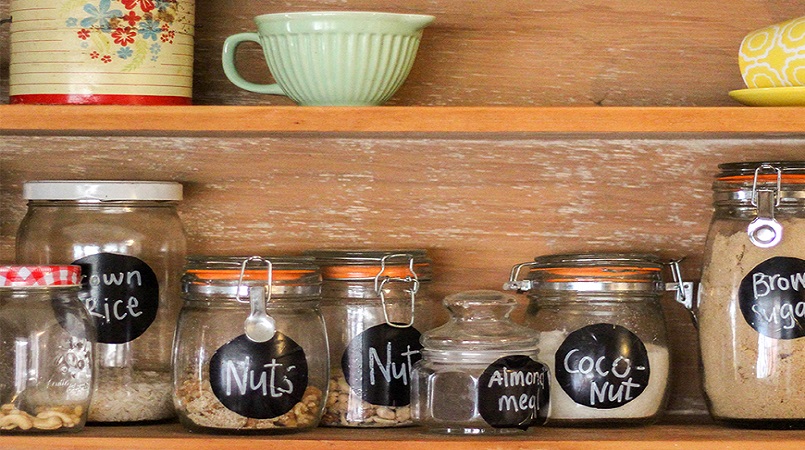
A well-stocked kitchen is a happy kitchen, because it’s one that’s filled with all the ingredients you need to cook the real meals you want to cook.
And real meals are so much better than the sad, pseudo-meals of a poorly stocked pantry (here’s looking at you, dehydrated ramen cups and stale potato chips).
But what exactly is a real meal? It’s usually one that’s full of the right balance of nutrients (fiber, protein, fat, complex carbohydrates), but also delicious and satisfying. These 12 ingredients are the ones you’ll want to fill your pantry with to make these kinds of meals a regular reality.
1. Tomato paste
Tomato paste is a miracle ingredient. You can use it to thicken stews and soups and make amazing marinara sauces. And a little goes a long way—you only really need to use a tablespoon at a time and one can will typically cost you under a dollar. Kristina DeMuth, M.P.H., R.D., L.D., social media director for Nutritionfacts.org, says it’s also great to have on hand because it’s full of vitamin C and lycopene, which is an antioxidant shown to improve heart health. Plus, 1 tablespoon of tomato paste counts as a 1/4-cup serving of vegetables.
2. Whole grain products
There are so many whole grain products you should try to keep on hand. Brown rice, quinoa, oatmeal, whole grain pasta—these foods are all full of protein, fiber, and complex carbohydrates. They’re affordable, and can be used to round out just about any meal. Plus, if stored properly, they can last for a pretty long time.
3. Root vegetables and squash
Though, yes, you’ll want to either refrigerate or freeze most vegetables, certain root veggies and squash varietals are the exception to that rule. Root vegetables include potatoes (both sweet and regular), onions, and yams. Winter squash such as spaghetti, kabocha, and butternut, and even pumpkins, can also be stored in your pantry.
4. Canned beans
Beans, and especially canned beans, are great. They’re full of protein and fiber, and are easy to prepare in mere minutes. You can use chickpeas in hummus, black beans in brownies, white beans in salads—there are seriously so many options.
5. Dried lentils
Lentils, like beans, are full of protein and fiber. Unlike beans, they aren’t usually sold in cans, so you have to buy them dried. They’re typically super cheap, but they do take a bit longer to cook (usually 20 to 30 minutes). Make a bunch at once, pack them up in food storage containers, keep them in your fridge or freezer, and use them in everything from soups to salads.
6. Canned fish
This is another super simple, ready-to-eat protein to keep on hand. Salmon, tuna, and anchovies are all good varieties of fish to keep in your pantry. They’re full of vitamin D and healthy fats, and you can use them in salads and sandwiches. Even throw anchovies into salad dressings and tomato sauces for a salty, umami kick.
7. Spices and herbs
These ingredients are what make your dishes flavorful, without kicking up the calorie count. A few good spices to have on hand include kosher salt and black pepper (obviously), cinnamon, cayenne, cumin, and nutmeg. DeMuth also loves to keep her pantry stocked with turmeric (AKA the super-spice du jour). A few good herbs to keep around are dried rosemary, thyme, dill, or whatever you like the taste of.
8. Nuts, seeds, and nut butters
Nuts and seeds are incredibly versatile. You can use them in sweet dishes like oatmeal, pancakes, and granola or use them to top salads, soups, and even pastas. They’re high in both protein and fiber, and when stored properly they can last for a while before they start to get a little stale and chewy.
Nut butters, in that same vein, are another great ingredient to have. Use them in salad dressings, sandwiches, or just eat them by the spoonful (in moderation, though, because they are high in calories).
9. Extra-virgin olive oil
Extra-virgin is the best of the best, the cream of the crop, and, dare I say, the slickest of the oils. It’s a bit pricier, and you’ll want to watch out for fraudulent bottles using this guide, but all that extra work is worth it. It’s full of heart-healthy monounsaturated fats, and it tastes amazing. Save your more expensive bottles for vegetable drizzling and bread dipping, and your cheaper bottles for cooking.
10. Vinegars
One of the key ingredients to vinaigrette (le duh), vinegar is a huge pantry staple. There are a few different varieties you’ll want to gather: Balsamic, apple cider, white wine, red wine, and standard white vinegars are all good to have for different purposes. Their uses go beyond salad dressings. Balsamic with a bit of olive oil and salt is great for dipping bread into, while white vinegar can be used to make pie crust (and even in homemade cleaning solutions).
11. Nutritional yeast
This ingredient is extremely popular in the vegan community because of it’s cheesy characteristics. You can use it to make dairy-free mac and cheese, queso dip, or whatever you want—a little experimenting is never a bad idea. Keep this tightly sealed and stored in a cool, dark place as yeast is an active ingredient.
12. Garlic
Though this may seem like an ingredient that needs to be refrigerated, it doesn’t. The moisture from the refrigerator will cause garlic to become soft and hard to handle, and it might even make it go bad faster. Garlic is another delicious, low-calorie flavoring agent that can be used easily in myriad dishes.
